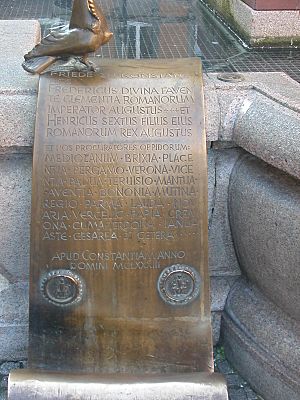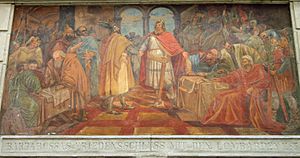Peace of Constance facts for kids
The Peace of Constance was a very important agreement signed on June 25, 1183. It was like a special permission or "privilege" given by Frederick I, Holy Roman Emperor, also known as Frederick Barbarossa, and his son Henry VI. This agreement officially ended a long war that had been going on since 1167 between the Emperor and a group of powerful Italian cities called the Lombard League.
This peace was meant to last forever. It replaced an earlier six-year ceasefire (a temporary stop to fighting) that was agreed upon in 1177 with the Treaty of Venice.
As the ceasefire was ending, Emperor Frederick and the Lombard League started talking in early 1183. They exchanged many ideas and suggestions. They even settled a separate argument about the city of Alessandria. A first agreement was signed in Piacenza, which then became the main plan for the final peace. Because the Emperor was technically the ruler of these cities, he couldn't sign a "treaty" with his own subjects. So, the agreement was presented as a special "imperial privilege" instead.
Contents
What the Peace of Constance Meant
The Peace of Constance confirmed many points from the earlier 1177 Treaty of Venice. It gave the cities in the Kingdom of Italy a lot of freedom.
How Cities Gained Freedom
The agreement allowed the cities to:
- Keep many of their local rights and powers over their lands. These rights were called "regalia."
- Freely choose their own city leaders, called "consuls."
- Create their own laws.
- Continue their alliance with the Lombard League.
What Cities Owed the Emperor
Even with these freedoms, the cities still had some duties to the Emperor:
- They had to promise loyalty to the Holy Roman Emperor. This promise was called an "oath of fealty."
- Their consuls (city leaders) had to be officially approved by the Emperor himself.
- Imperial judges (judges chosen by the Emperor) could hear appeals from city court decisions. An appeal is when someone asks a higher court to review a decision.
- Some areas in Italy were directly controlled by the Emperor.
- Cities could handle most criminal and civil cases. However, if a case involved more than 25 pounds of gold, the Emperor's judges would handle the appeal.
What Happened After the Peace
One expert, Baldo degli Ubaldi, wrote that the Emperor could technically change parts of the agreement later. However, the Hohenstaufen family, who ruled for 67 years after this peace, never tried to break the agreement.
The cities stopped following their duties after Emperor Henry VI died in 1197. This led to new conflicts. The Peace of Constance became a central issue in another war between a "second Lombard League" and Emperor Frederick II from 1226 to 1250.
Despite these later conflicts, the Peace of Constance was celebrated for centuries. It was seen as the only time an Emperor officially recognized the independence of a large group of Italian cities.
Important Points from the Agreement
The Peace of Constance was a long document. Here are some of the most important parts, explained simply:
- Forever Granted Rights: Emperor Frederick and his son Henry officially gave the cities of the Lombard League the right to control their own lands and use their traditional customs forever. This included things like collecting taxes (fodrum), using woods and pastures, and controlling bridges and water.
- Choosing Leaders: Cities could choose their own consuls (leaders). These consuls would then be officially approved by the Emperor's representative every five years.
- Loyalty Oath: All elected consuls had to swear an oath of loyalty to the Emperor. Also, all citizens between 15 and 70 years old had to swear loyalty.
- Appeals: If someone wanted to appeal a court decision, they could appeal to the Emperor's representative. This representative would be in Italy and would make a decision within two months.
- City Fortifications: The cities were allowed to build and keep their own defenses and walls.
- Continuing the League: The Lombard League was allowed to continue and renew its alliance whenever its members wished. This was a big win for the cities.
- No Harm to Cities: The Emperor promised not to stay in any city longer than needed if it would cause harm to the city.
- Forgiveness: The Emperor forgave all damages and injuries caused by the League or its members during the war.
- Roads and Supplies: When the Emperor traveled through Lombardy, the cities had to help repair roads and bridges. They also had to provide enough food for the Emperor and his followers.
Cities and Representatives
Many cities and their representatives were part of this peace. Here are some of the cities that accepted the peace and swore to follow it:
- Pavia
- Cremona
- Como
- Tortona
- Asti
- Alessandria (also called Cesarea)
- Genoa
- Alba
And here are some of the representatives who received official approval for their cities' leadership:
- Milan: Adobato
- Piacenza: Gerardo Ardizzoni
- Lodi: Vincenzo
- Verona: Cozio
- Vicenza: Pilio
- Padova: Gnaffo
- Treviso: Florio
- Mantova: Alessandrino
- Faenza: Bernardo
- Bologna: Antonino
- Modena: Arlotto
- Reggio: Rolando
- Parma: Giacomo di Pietro Bave
- Novara: Opizzo
- Vercelli: Medardo
- Bergamo: Attone Ficiano
Images for kids





